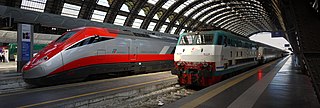
The Italian railway system is one of the most important parts of the infrastructure of Italy, with a total length of 24,567 km (15,265 mi) of which active lines are 16,832 km (10,459 mi). The network has recently grown with the construction of the new high-speed rail network. Italy is a member of the International Union of Railways (UIC). The UIC Country Code for Italy is 83.

The Italian railway system is one of the most important parts of the infrastructure of Italy, with a total length of 24,227 km (15,054 mi) as of 2011.

The Milan–Bologna railway is the northern part of the traditional main north–south trunk line of the Italian railway network. It closely follows the ancient Roman Road, the Via Aemilia. The line was opened between 1859 and 1861 as a single-line railway, and was doubled between 1866 and 1894. It was electrified at 3,000 volts DC in 1938. High-speed trains on the route have used the parallel Milan–Bologna high-speed line since 13 December 2008.

The Milan–Venice railway line is one of the most important railway lines in Italy. It connects the major city of Milan, in Lombardy, with the Adriatic Sea at Venice, in Veneto. The line is state-owned and operated by the state rail infrastructure company, Rete Ferroviaria Italiana that classifies it as a trunk line. The line is electrified at 3,000 volts DC.

Taranto railway station is the main station serving the city and comune of Taranto, in the region of Apulia, southern Italy. Opened in 1868, it forms a junction between three main lines, from Bari, Brindisi and Reggio di Calabria, respectively. It is also a terminus of a secondary line, the Bari–Martina Franca–Taranto railway.

Bergamo railway station serves the city and comune of Bergamo, in the region of Lombardy, northern Italy. Opened in 1854, it is located at the junction of lines to Brescia, Lecco, Seregno and Treviglio.

Brescia railway station is the main station of Brescia, in the region of Lombardy, northern Italy. The station, opened in 1854, lies on the Milan-Venice railway and is a terminus of three branch lines: Valcamonica Railway to Edolo, Bergamo–Brescia railway and Brescia–Piadena/Cremona railway which branches off towards southeast of the station.

Desenzano del Garda-Sirmione station is a railway station serving the town and comune of Desenzano del Garda, in the region of Lombardy, northern Italy. Opened in 1854, it forms part of the Milan–Venice railway.

Pesaro railway station serves the city and comune of Pesaro, in the region of Marche, central Italy. Opened in 1861, it forms part of the Bologna–Ancona railway.

Peschiera del Garda railway station serves the town and comune of Peschiera del Garda, in the region of Veneto, northern Italy. Opened in 1854, it forms part of the Milan–Venice railway.

Trenord is a railway company which is responsible for the operation of regional passenger trains in Lombardy. The company was established by the two main railway companies in Lombardy, Trenitalia and Ferrovie Nord Milano (FNM), to manage train operations in the region. The equity is equally divided between the two companies.

The Lecco–Bergamo railway is a railway line in Lombardy, Italy. The railway infrastructure is managed by the Rete Ferroviaria Italiana, which classifies it as one of its complementary lines. The passenger service is operated by Trenord as a regional service.

The Bologna–Ancona railway is an Italian railway that connects the city of Bologna with the city of Ancona, passing through the Po Valley to Rimini and along the Adriatic coast for the rest of the line.

Rovato is a railway station serving the town of Rovato, in the region of Lombardy, northern Italy. The station opened on 5 March 1878 and is located on the Milan–Venice railway and Bergamo–Brescia railway. The train services are operated by Trenord.
The Milan–Verona high-speed railway is an Italian 165-kilometre (103-mile) long high-speed railway line, that is partly open and partly under construction to connect Milan with Verona. The route operates through the regions of Lombardy and Veneto. The line is part of Railway axis 6 of the Trans-European rail network (TEN-T) on the Pan-European Corridor V. The line will replace the Milan–Venice railway for high-speed trains.
The Società anonima delle strade ferrate della Lombardia e dell'Italia Centrale was a joint-stock Anglo-French-Italian private company formed, following the partition of the territory, and the railways built in it, under construction or planned, resulting from the defeat of Austria in the Second Italian War of Independence, following the convention of 25 June 1860 among the Ministers of King Vittorio Emanuele II for Public Works and Finance and the previous Imperial-regia società privilegiata delle strade ferrate lombardo-venete e dell'Italia Centrale.
The Fidenza–Fornovo railway is an Italian railway line connecting Fidenza and Fornovo di Taro in the Italian region of Emilia-Romagna. It is managed by Rete Ferroviaria Italiana.

Olmeneta railway station is a railway station serving the town and comune of Olmeneta in the region of Lombardy, Northern Italy. The station is located at the junction of the Brescia–Cremona and Treviglio–Cremona railway lines.

Castelleone railway station is a railway station serving the town and comune of Castelleone in the region of Lombardy, Northern Italy. It is located on the Treviglio–Cremona railway.





















